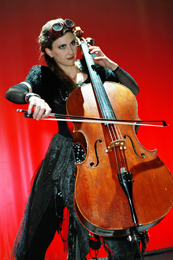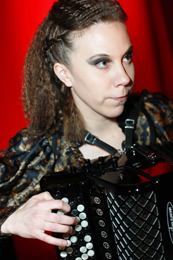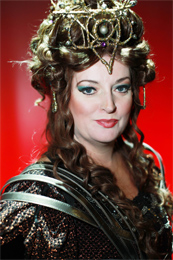Cork Opera House’s production of Dido and Aeneas can teach the viewer a lot about Baroque opera and how it can be productively recreated in the twenty-first century. At a time dominated by the so-called 'historic performance practice', or the attempt to perform music from the Baroque and earlier periods as faithfully as possible in the style and on the instruments of the time of origin, this version shows that sometimes engaging with the spirit of the piece can be more rewarding than clinging to the letters of the score.
 The opera begins with four female musicians standing on stage, commencing the overture. They don’t read their parts; in fact, they have memorised the entire music – no mean feat given a score of some 75 minutes’ duration. This makes them mobile; they can walk around and interact with each other or the singers while playing. But the differences to a ‘normal’ production don’t end there. The four don’t play the string instruments indicated in Purcell’s score from 1688. On the foundation of Ilse de Ziah’s cello line, Piia Pakarinen plays the accordion, while the other two performers switch between a number of instruments: Carolyn Goodwin plays clarinet, bass clarinet, soprano and alto saxophone – and last but not least tambourine; while Marja Gaynor (who arranged the score for this salon ensemble with the help of the other three) alternates between violin, viola, autoharp and melodica.
The opera begins with four female musicians standing on stage, commencing the overture. They don’t read their parts; in fact, they have memorised the entire music – no mean feat given a score of some 75 minutes’ duration. This makes them mobile; they can walk around and interact with each other or the singers while playing. But the differences to a ‘normal’ production don’t end there. The four don’t play the string instruments indicated in Purcell’s score from 1688. On the foundation of Ilse de Ziah’s cello line, Piia Pakarinen plays the accordion, while the other two performers switch between a number of instruments: Carolyn Goodwin plays clarinet, bass clarinet, soprano and alto saxophone – and last but not least tambourine; while Marja Gaynor (who arranged the score for this salon ensemble with the help of the other three) alternates between violin, viola, autoharp and melodica.
But there is still one ingredient missing to understand this special take on Purcell: the playing techniques are often modern, enriched by elements of improvisation, and the many Baroque dances in particular are 'transformed' into modern genres. Goodwin, for example, plays Purcell’s melodic line in the overture all right, but her wailing clarinet’s free approach to sometimes sudden, sometimes gentle tempo changes, expressive dynamics and unconventional accentuation leaves the listener with a  distinctive impression of klezmer music. In the first sorceress scene, the 'Be ere we this perform' duet is transformed into a tango played by cello and accordion (and danced by Gaynor and Goodwin) while the two vocal lines remain unchanged. Elsewhere, there are jazz inflections, or we suddenly feel like in a cabaret in between-the-wars Paris or Weimar Berlin while the transitions between scenes are often accompanied by modern sound effects, such as col legno play, atonal glissandi or the percussive use of the string instruments. Given the improvisatory elements, we can be sure that no two performances of this production will be exactly alike.
distinctive impression of klezmer music. In the first sorceress scene, the 'Be ere we this perform' duet is transformed into a tango played by cello and accordion (and danced by Gaynor and Goodwin) while the two vocal lines remain unchanged. Elsewhere, there are jazz inflections, or we suddenly feel like in a cabaret in between-the-wars Paris or Weimar Berlin while the transitions between scenes are often accompanied by modern sound effects, such as col legno play, atonal glissandi or the percussive use of the string instruments. Given the improvisatory elements, we can be sure that no two performances of this production will be exactly alike.
None of this is of course what Purcell could have imagined, but it reminds us that Baroque instrumental music was not at all 'classical' in the seventeenth century but rather the popular music of its time. It was then quite common to use the instruments to hand if the ones indicated in the score were not available, to improvise middle parts over the harmonic fundament of a given bass line, and to change parts according to the abilities of singers or instrumentalists and the taste of a local audience. Sure, Purcell knew neither tango nor accordion, but then, Bach knew no modern grand piano either, yet we perform his keyboard music on it more often than on any other instrument. So the adaptation is made in a spirit not that far away from what was common at Purcell’s time.
 Much of the success of this production lies, of course, with the creative team led by director and set designer John O’Brien. He decided to limit the number of singers to four and not use a choir, letting Dido and her two maids appear as the sorceress and her two witches as well. This means that Dido gets to plot her own demise by engineering Aeneas’ sudden departure. Cara O’Sullivan provides a strong presence on stage, equally credible in her lyrical yearning for her lover as in her evil, mischievous plotting as sorceress, ably assisted in both roles by Majella Cullagh and Mary Hegarty. Her highlight is of course Dido’s dying lament after her prince has left her. Tenor Simon Morgan presents his dashing Aeneas with almost baritonal verve and power, yet he also sings the sailor and the spirit, the latter as a ventriloquist in falsetto register operating a sinister-looking damaged doll borrowed from a Stephen King movie. To the director, the set and the costumes represent “a dark, goth, emo world”, yet Lisa Zagone’s costumes are not that far away from some of the phantasy outfits that we can see in Baroque depictions of actors and singers on stage (who were responsible for selecting their own costumes at the time).
Much of the success of this production lies, of course, with the creative team led by director and set designer John O’Brien. He decided to limit the number of singers to four and not use a choir, letting Dido and her two maids appear as the sorceress and her two witches as well. This means that Dido gets to plot her own demise by engineering Aeneas’ sudden departure. Cara O’Sullivan provides a strong presence on stage, equally credible in her lyrical yearning for her lover as in her evil, mischievous plotting as sorceress, ably assisted in both roles by Majella Cullagh and Mary Hegarty. Her highlight is of course Dido’s dying lament after her prince has left her. Tenor Simon Morgan presents his dashing Aeneas with almost baritonal verve and power, yet he also sings the sailor and the spirit, the latter as a ventriloquist in falsetto register operating a sinister-looking damaged doll borrowed from a Stephen King movie. To the director, the set and the costumes represent “a dark, goth, emo world”, yet Lisa Zagone’s costumes are not that far away from some of the phantasy outfits that we can see in Baroque depictions of actors and singers on stage (who were responsible for selecting their own costumes at the time).
The set – unchanged throughout the performance – consists of a rotating metal throne that doubles as a bed, and with the help of a number of spots can also appear as a crown.
Neither voices nor instruments benefit from not being enveloped in their own reverberations, as was caused by the slightly dry acoustics of the Mermaid Arts Centre – but the vigour, enthusiasm and creativity of everyone on stage as well as behind it make this production a truly memorable experience.
Wolfgang Marx